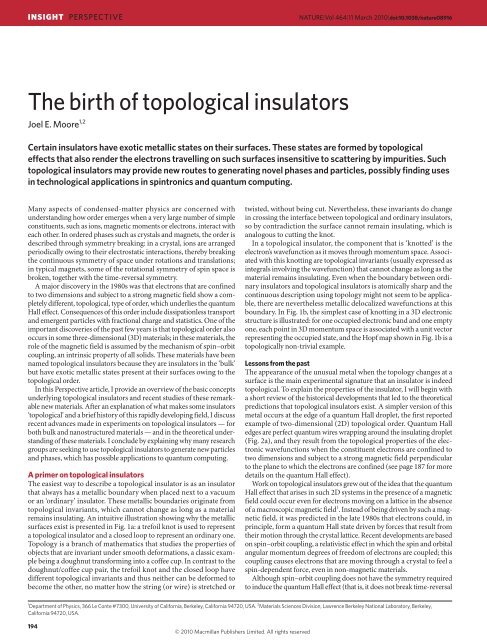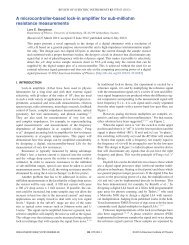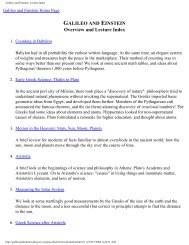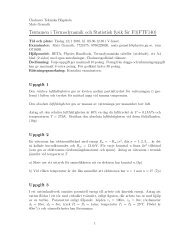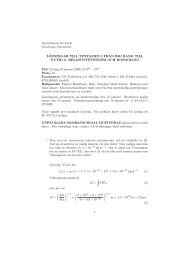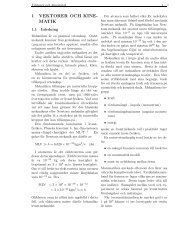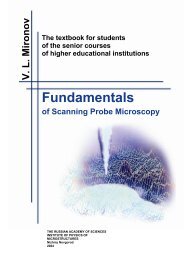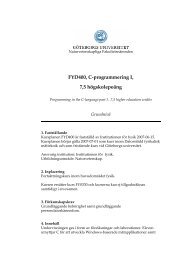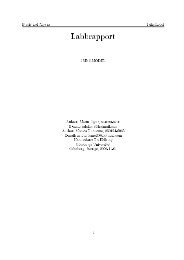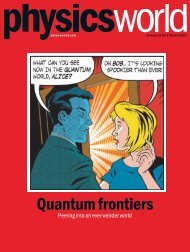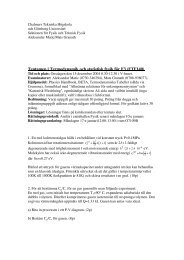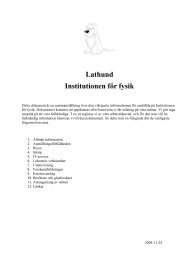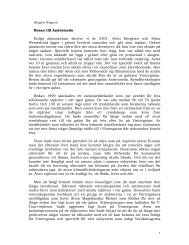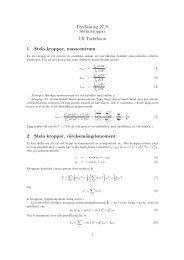The birth of topological insulators
The birth of topological insulators
The birth of topological insulators
Create successful ePaper yourself
Turn your PDF publications into a flip-book with our unique Google optimized e-Paper software.
INSIGHT PERSPECTIVENATURE|Vol 464|11 March 2010|doi:10.1038/nature08916<strong>The</strong> <strong>birth</strong> <strong>of</strong> <strong>topological</strong> <strong>insulators</strong>Joel E. Moore 1,2Certain <strong>insulators</strong> have exotic metallic states on their surfaces. <strong>The</strong>se states are formed by <strong>topological</strong>effects that also render the electrons travelling on such surfaces insensitive to scattering by impurities. Such<strong>topological</strong> <strong>insulators</strong> may provide new routes to generating novel phases and particles, possibly finding usesin technological applications in spintronics and quantum computing.Many aspects <strong>of</strong> condensed-matter physics are concerned withunderstanding how order emerges when a very large number <strong>of</strong> simpleconstituents, such as ions, magnetic moments or electrons, interact witheach other. In ordered phases such as crystals and magnets, the order isdescribed through symmetry breaking: in a crystal, ions are arrangedperiodically owing to their electrostatic interactions, thereby breakingthe continuous symmetry <strong>of</strong> space under rotations and translations;in typical magnets, some <strong>of</strong> the rotational symmetry <strong>of</strong> spin space isbroken, together with the time-reversal symmetry.A major discovery in the 1980s was that electrons that are confinedto two dimensions and subject to a strong magnetic field show a completelydifferent, <strong>topological</strong>, type <strong>of</strong> order, which underlies the quantumHall effect. Consequences <strong>of</strong> this order include dissipationless transportand emergent particles with fractional charge and statistics. One <strong>of</strong> theimportant discoveries <strong>of</strong> the past few years is that <strong>topological</strong> order alsooccurs in some three-dimensional (3D) materials; in these materials, therole <strong>of</strong> the magnetic field is assumed by the mechanism <strong>of</strong> spin–orbitcoupling, an intrinsic property <strong>of</strong> all solids. <strong>The</strong>se materials have beennamed <strong>topological</strong> <strong>insulators</strong> because they are <strong>insulators</strong> in the ‘bulk’but have exotic metallic states present at their surfaces owing to the<strong>topological</strong> order.In this Perspective article, I provide an overview <strong>of</strong> the basic conceptsunderlying <strong>topological</strong> <strong>insulators</strong> and recent studies <strong>of</strong> these remarkablenew materials. After an explanation <strong>of</strong> what makes some <strong>insulators</strong>‘<strong>topological</strong>’ and a brief history <strong>of</strong> this rapidly developing field, I discussrecent advances made in experiments on <strong>topological</strong> <strong>insulators</strong> — forboth bulk and nanostructured materials — and in the theoretical understanding<strong>of</strong> these materials. I conclude by explaining why many researchgroups are seeking to use <strong>topological</strong> <strong>insulators</strong> to generate new particlesand phases, which has possible applications to quantum computing.A primer on <strong>topological</strong> <strong>insulators</strong><strong>The</strong> easiest way to describe a <strong>topological</strong> insulator is as an insulatorthat always has a metallic boundary when placed next to a vacuumor an ‘ordinary’ insulator. <strong>The</strong>se metallic boundaries originate from<strong>topological</strong> invariants, which cannot change as long as a materialremains insulating. An intuitive illustration showing why the metallicsurfaces exist is presented in Fig. 1a: a trefoil knot is used to representa <strong>topological</strong> insulator and a closed loop to represent an ordinary one.Topology is a branch <strong>of</strong> mathematics that studies the properties <strong>of</strong>objects that are invariant under smooth deformations, a classic examplebeing a doughnut transforming into a c<strong>of</strong>fee cup. In contrast to thedoughnut/c<strong>of</strong>fee cup pair, the trefoil knot and the closed loop havedifferent <strong>topological</strong> invariants and thus neither can be deformed tobecome the other, no matter how the string (or wire) is stretched ortwisted, without being cut. Nevertheless, these invariants do changein crossing the interface between <strong>topological</strong> and ordinary <strong>insulators</strong>,so by contradiction the surface cannot remain insulating, which isanalogous to cutting the knot.In a <strong>topological</strong> insulator, the component that is ‘knotted’ is theelectron’s wavefunction as it moves through momentum space. Associatedwith this knotting are <strong>topological</strong> invariants (usually expressed asintegrals involving the wavefunction) that cannot change as long as thematerial remains insulating. Even when the boundary between ordinary<strong>insulators</strong> and <strong>topological</strong> <strong>insulators</strong> is atomically sharp and thecontinuous description using topology might not seem to be applicable,there are nevertheless metallic delocalized wavefunctions at thisboundary. In Fig. 1b, the simplest case <strong>of</strong> knotting in a 3D electronicstructure is illustrated: for one occupied electronic band and one emptyone, each point in 3D momentum space is associated with a unit vectorrepresenting the occupied state, and the Hopf map shown in Fig. 1b is a<strong>topological</strong>ly non-trivial example.Lessons from the past<strong>The</strong> appearance <strong>of</strong> the unusual metal when the topology changes at asurface is the main experimental signature that an insulator is indeed<strong>topological</strong>. To explain the properties <strong>of</strong> the insulator, I will begin witha short review <strong>of</strong> the historical developments that led to the theoreticalpredictions that <strong>topological</strong> <strong>insulators</strong> exist. A simpler version <strong>of</strong> thismetal occurs at the edge <strong>of</strong> a quantum Hall droplet, the first reportedexample <strong>of</strong> two-dimensional (2D) <strong>topological</strong> order. Quantum Halledges are perfect quantum wires wrapping around the insulating droplet(Fig. 2a), and they result from the <strong>topological</strong> properties <strong>of</strong> the electronicwavefunctions when the constituent electrons are confined totwo dimensions and subject to a strong magnetic field perpendicularto the plane to which the electrons are confined (see page 187 for moredetails on the quantum Hall effect).Work on <strong>topological</strong> <strong>insulators</strong> grew out <strong>of</strong> the idea that the quantumHall effect that arises in such 2D systems in the presence <strong>of</strong> a magneticfield could occur even for electrons moving on a lattice in the absence<strong>of</strong> a macroscopic magnetic field 1 . Instead <strong>of</strong> being driven by such a magneticfield, it was predicted in the late 1980s that electrons could, inprinciple, form a quantum Hall state driven by forces that result fromtheir motion through the crystal lattice. Recent developments are basedon spin–orbit coupling, a relativistic effect in which the spin and orbitalangular momentum degrees <strong>of</strong> freedom <strong>of</strong> electrons are coupled; thiscoupling causes electrons that are moving through a crystal to feel aspin-dependent force, even in non-magnetic materials.Although spin–orbit coupling does not have the symmetry requiredto induce the quantum Hall effect (that is, it does not break time-reversal1 Department <strong>of</strong> Physics, 366 Le Conte #7300, University <strong>of</strong> California, Berkeley, California 94720, USA. 2 Materials Sciences Division, Lawrence Berkeley National Laboratory, Berkeley,California 94720, USA.194© 2010Macmillan Publishers Limited. All rights reserved
NATURE|Vol 464|11 March 2010PERSPECTIVE INSIGHTabFigure 1 | Metallic states are born when a surface unties ‘knotted’ electronwavefunctions. a, An illustration <strong>of</strong> <strong>topological</strong> change and the resultantsurface state. <strong>The</strong> trefoil knot (left) and the simple loop (right) representdifferent insulating materials: the knot is a <strong>topological</strong> insulator, and theloop is an ordinary insulator. Because there is no continuous deformationby which one can be converted into the other, there must be a surface wherethe string is cut, shown as a string with open ends (centre), to pass betweenthe two knots; more formally, the <strong>topological</strong> invariants cannot remaindefined. If the <strong>topological</strong> invariants are always defined for an insulator,then the surface must be metallic. b, <strong>The</strong> simplest example <strong>of</strong> a knotted 3Delectronic band structure (with two bands) 35 , known to mathematicians asthe Hopf map. <strong>The</strong> full <strong>topological</strong> structure would also have linked fibreson each ring, in addition to the linking <strong>of</strong> rings shown here. <strong>The</strong> knottingin real <strong>topological</strong> <strong>insulators</strong> is more complex as these require a minimum<strong>of</strong> four electronic bands, but the surface structure that appears is relativelysimple (Fig. 3).symmetry as an applied magnetic field would), in simplified modelsintroduced in around 2003 it can lead to a quantum spin Hall effect,in which electrons with opposite spin angular momentum (commonlycalled spin up and spin down) move in opposite directions around theedge <strong>of</strong> the droplet in the absence <strong>of</strong> an external magnetic field 2 (Fig. 2b).<strong>The</strong>se simplified models were the first steps towards understanding<strong>topological</strong> <strong>insulators</strong>. But it was unclear how realistic the models were:in real materials, there is mixing <strong>of</strong> spin-up and spin-down electrons,and there is no conserved spin current. It was also unclear whether theedge state <strong>of</strong> the droplet in Fig. 2b would survive the addition <strong>of</strong> evena few impurities.In 2005, a key theoretical advance was made by Kane and Mele 3 .<strong>The</strong>y used more realistic models, without a conserved spin current,and showed how some <strong>of</strong> the physics <strong>of</strong> the quantum spin Hall effectcan survive. <strong>The</strong>y found a new type <strong>of</strong> <strong>topological</strong> invariant that couldbe computed for any 2D material and would allow the prediction <strong>of</strong>whether the material had a stable edge state. This allowed them to showthat, despite the edge not being stable in many previous models, there arerealistic 2D materials that would have a stable edge state in the absence <strong>of</strong>a magnetic field; the resultant 2D state was the first <strong>topological</strong> insulatorto be understood. This non-magnetic insulator has edges that act likeperfectly conducting one-dimensional electronic wires at low temperatures,similar to those in the quantum Hall effect.Subsequently, Bernevig, Hughes and Zhang made a theoreticalprediction that a 2D <strong>topological</strong> insulator with quantized charge conductancealong the edges would be realized in (Hg,Cd)Te quantumwells 4 . <strong>The</strong> quantized charge conductance was indeed observed in thissystem, as a quantum-Hall-like plateau in zero magnetic field, in 2007(ref. 5). <strong>The</strong>se experiments are similar to those on the quantum Halleffect in that they require, at least so far, low temperature and artificial2D materials (quantum wells), but they differ in that no magnetic fieldis needed.Going 3D<strong>The</strong> next important theoretical development, in 2006, was therealization 6–8 that even though the quantum Hall effect does not generalizeto a genuinely 3D state, the <strong>topological</strong> insulator does, in a subtle way.Although a 3D ‘weak’ <strong>topological</strong> insulator can be formed by layering2D versions, similar to layered quantum Hall states, the resultant stateis not stable to disorder, and its physics is generally similar to that <strong>of</strong> the2D state. In weak <strong>topological</strong> <strong>insulators</strong>, a dislocation (a line-like defectin the crystal) will always contain a quantum wire like that at the edge<strong>of</strong> the quantum spin Hall effect (discussed earlier), which may allow 2D<strong>topological</strong> insulator physics to be observed in a 3D material 9 .<strong>The</strong>re is also, however, a ‘strong’ <strong>topological</strong> insulator, which has amore subtle relationship to the 2D case; the relationship is that in twodimensions it is possible to connect ordinary <strong>insulators</strong> and <strong>topological</strong><strong>insulators</strong> smoothly by breaking time-reversal symmetry 7 . Such acontinuous interpolation can be used to build a 3D band structure thatrespects time-reversal symmetry, is not layered and is <strong>topological</strong>ly nontrivial.It is this strong <strong>topological</strong> insulator that has protected metallicsurfaces and has been the focus <strong>of</strong> experimental activity.Spin–orbit coupling is again required and must mix all components <strong>of</strong>the spin. In other words, there is no way to obtain the 3D strong <strong>topological</strong>insulator from separate spin-up and spin-down electrons, unlike inthe 2D case. Although this makes it difficult to picture the bulk physics <strong>of</strong>the 3D <strong>topological</strong> insulator (only the strong <strong>topological</strong> insulator will bediscussed from this point), it is simple to picture its metallic surface 6 .<strong>The</strong> unusual planar metal that forms at the surface <strong>of</strong> <strong>topological</strong><strong>insulators</strong> ‘inherits’ <strong>topological</strong> properties from the bulk insulator.<strong>The</strong> simplest manifestation <strong>of</strong> this bulk–surface connection occurs ata smooth surface, where momentum along the surface remains welldefined: each momentum along the surface has only a single spin stateat the Fermi level, and the spin direction rotates as the momentummoves around the Fermi surface (Fig. 3). When disorder or impuritiesare added at the surface, there will be scattering between these surfacestates but, crucially, the <strong>topological</strong> properties <strong>of</strong> the bulk insulator donot allow the metallic surface state to vanish — it cannot become localizedor gapped. <strong>The</strong>se two theoretical predictions, about the electronicstructure <strong>of</strong> the surface state and the robustness to disorder <strong>of</strong> its metallicbehaviour, have led to a flood <strong>of</strong> experimental work on 3D <strong>topological</strong><strong>insulators</strong> in the past two years.Experimental realizations<strong>The</strong> first <strong>topological</strong> insulator to be discovered was the alloy Bi x Sb 1−x ,the unusual surface bands <strong>of</strong> which were mapped in an angle-resolvedphotoemission spectroscopy (ARPES) experiment 10,11 . In ARPES experiments,a high-energy photon is used to eject an electron from a crystal,and then the surface or bulk electronic structure is determined from ananalysis <strong>of</strong> the momentum <strong>of</strong> the emitted electron. Although the surfacestructure <strong>of</strong> this alloy was found to be complex, this work launched asearch for other <strong>topological</strong> <strong>insulators</strong>.© 2010Macmillan Publishers Limited. All rights reserved195
INSIGHT PERSPECTIVENATURE|Vol 464|11 March 2010aOrdinary insulatorbOrdinary insulatore–Integer quantum Hall state(n = 1)Idealized quantum spin Hall stateFigure 2 | Topological order in two dimensions. a, Edge <strong>of</strong> an integerquantum Hall state. <strong>The</strong> electrons (e – ) are confined to a 2D insulatingdroplet with a metallic edge. Along the edge, electrons propagate only inone direction, which is determined by the sign <strong>of</strong> the applied magneticfield perpendicular to the droplet. One integer, n, the <strong>topological</strong> invariant,determines the Hall conductance and the number <strong>of</strong> propagating edgemodes. b, Edge <strong>of</strong> an idealized quantum spin Hall state (that is, a 2D<strong>topological</strong> insulator). Along the edge, spin-up electrons move clockwise,whereas spin-down electrons move anticlockwise. Spin-up and spin-downelectrons are independent and are in oppositely directed quantum Hallstates. An applied electrical field generates a spin current but no chargecurrent. Each droplet is surrounded by an ordinary insulator.For a <strong>topological</strong> insulator to form, spin–orbit coupling must be strongenough to modify the electronic structure significantly, which suggeststhat heavy-element, small-bandgap semiconductors are the most promisingcandidates. This suggestion stems from two points. First, spin–orbitcoupling is a relativistic effect and is only strong for heavy elements. Second,if the bandgap is much larger than the energy scale <strong>of</strong> spin–orbitcoupling, then spin–orbit coupling will not be able to change the phase.<strong>The</strong> search for <strong>topological</strong> <strong>insulators</strong> culminated in the recent discovery<strong>of</strong> <strong>topological</strong> insulator behaviour in Bi 2 Se 3 and Bi 2 Te 3 (refs 12–14). <strong>The</strong>se‘next-generation’ materials both show <strong>topological</strong> insulator behaviour upto higher temperatures than does the original material (Bi x Sb 1−x ), withbulk bandgaps <strong>of</strong> more than 0.1 eV, and have the simplest surface statethat is allowed. Beyond providing further confirmation <strong>of</strong> the theory<strong>of</strong> <strong>topological</strong> <strong>insulators</strong>, the simplicity <strong>of</strong> the surface state in thesematerials opens up the possibility <strong>of</strong> many experiments, some <strong>of</strong> whichare described below. Furthermore, the large bandgap means that theseexperiments do not need to be carried out at extremely low temperatures.<strong>The</strong> main remaining complication about these materials, especially whenusing experimental techniques that do not distinguish directly betweenbulk states and surface states (unlike ARPES), is that in the bulk state theyhave residual conductivity arising from impurities.A graphene lookalikeFigure 3 shows the measured surface state <strong>of</strong> Bi 2 Se 3 and a theoreticalidealization <strong>of</strong> its state, including the electron spin. <strong>The</strong> surface state <strong>of</strong>the next-generation <strong>topological</strong> <strong>insulators</strong> is closely related to the Diracelectronic structure <strong>of</strong> graphene, which has a linear energy–momentumrelationship like that <strong>of</strong> a relativistic particle (and is known as a Diraccone). Graphene, which consists <strong>of</strong> a single layer <strong>of</strong> carbon atoms, hasbeen an extremely active subject <strong>of</strong> research in recent years 15 : it is interestingboth structurally, because it is the most 2D material possible, andelectronically, because <strong>of</strong> its linear energy–momentum relationship. <strong>The</strong>main difference between the surface <strong>of</strong> a <strong>topological</strong> insulator and that<strong>of</strong> graphene is that the <strong>topological</strong> insulator has only one Dirac point (orvalley) and no spin degeneracy, whereas graphene has two Dirac pointsand is spin degenerate. This difference has far-reaching consequences,including the possibility <strong>of</strong> generating new particles that have applicationsin quantum computing.Another remarkable consequence <strong>of</strong> the absence <strong>of</strong> the extradegeneracies was detected by scanning tunnelling microscopy experiments16–18 : the interference patterns near defects or steps on the surfaceshow that electrons are never completely reflected when scattered. Evenif the disorder becomes much stronger and a description in terms <strong>of</strong>well-separated scattering events is invalid, the surface remains metallic 19 .This protection <strong>of</strong> the surface metal from Anderson localization (thatis, formation <strong>of</strong> an insulating state as a result <strong>of</strong> strong disorder 20 ) is one<strong>of</strong> the key differences between the surface <strong>of</strong> the <strong>topological</strong> insulatorand the ‘accidental’ surface states present in other materials, such as thenoble metals. Beyond just being stable to disorder, it is now understoodthat the <strong>topological</strong> insulator, at least in some 2D models, forms as aresult <strong>of</strong> disorder 21,22 . In graphene, there is an approximate version <strong>of</strong>this protection if the scattering has a very smooth potential, but realgraphene is likely to become localized with strong disorder.<strong>The</strong>re was, however, initially a disadvantage in using a <strong>topological</strong>insulator for some purposes as opposed to graphene. In graphene, thechemistry <strong>of</strong> the carbon atoms naturally locates the Fermi level at theDirac point (that is, the point at which the two cones intersect), wherethe density <strong>of</strong> states vanishes. This means that the density <strong>of</strong> carriers ingraphene is highly tunable using an applied electrical field and allowsapplications <strong>of</strong> graphene in both basic science and microelectronics. <strong>The</strong>surface Fermi level <strong>of</strong> a <strong>topological</strong> insulator does not have any particularreason to sit at the Dirac point; however, through a combination <strong>of</strong>surface and bulk chemical modification, tuning to the Dirac point inBi 2 Se 3 was recently demonstrated 23 . This control <strong>of</strong> chemical potential isimportant for applications, as well as for a proposal to create a <strong>topological</strong>exciton condensate by biasing a thin film <strong>of</strong> <strong>topological</strong> insulator 24 .This condensate is a superfluid state <strong>of</strong> electron–hole pairs that wouldhave a bound electronic state around superfluid vortices.Materials challengesTwo recent advances in the nanostructuring <strong>of</strong> <strong>topological</strong> <strong>insulators</strong>also deserve a mention. Nanoribbons <strong>of</strong> Bi 2 Se 3 have been synthesized,allowing observation <strong>of</strong> the Aharonov–Bohm effect in the metallicsurface state when a magnetic field is applied along the long direction<strong>of</strong> the nanoribbon 25 , and molecular beam epitaxy has been used togrow thin films <strong>of</strong> Bi 2 Se 3 with controlled thickness down to a singleunit cell 26 . Such nanostructures are essential for many <strong>of</strong> the proposedapplications <strong>of</strong> <strong>topological</strong> <strong>insulators</strong> to spintronics and other fields.For example, the spin structure in Fig. 3 means that a charge currentalong the surface <strong>of</strong> the <strong>topological</strong> insulator automatically yields anon-zero spin density; a heterostructure that combines a <strong>topological</strong>insulator with a ferromagnet could allow the ferromagnet to beswitched by passing a current through the <strong>topological</strong> insulator’s surface,and this would be a new type <strong>of</strong> spin torque device for magneticmemory applications 27 . <strong>The</strong> next important steps are to carry outdirect transport and optical experiments on the metallic surface stateto measure its conductivity and spin properties, and for these experimentsimproved materials with reduced residual bulk conductivitymight be required.196© 2010Macmillan Publishers Limited. All rights reserved
NATURE|Vol 464|11 March 2010PERSPECTIVE INSIGHTA nascent fieldSeveral experiments that are under way are based on a different picture<strong>of</strong> the essential properties <strong>of</strong> a <strong>topological</strong> insulator, a picture that is connectedto particle physics research from the 1980s. It has been knownfor many years that the magnetic field and electric field are coupled inthe interior <strong>of</strong> some <strong>insulators</strong>. Topological <strong>insulators</strong> contain a specialtype <strong>of</strong> such coupling that is quantized and was originally discussed byparticle physicists who were analysing the coupling <strong>of</strong> an axion particleto ordinary electric and magnetic fields.Particle physics and superfluidityCondensed-matter physicists <strong>of</strong>ten seek to define a phase <strong>of</strong> matterin terms <strong>of</strong> its response to some influence. For example, a solid is amaterial with a non-zero stiffness in response to applied shear force,and a superconductor is defined in terms <strong>of</strong> the Meissner effect (thatis, by its expulsion <strong>of</strong> applied magnetic fields). Such definitions areconnected directly to experimentation and are independent <strong>of</strong> detailson the microscopic level. It turns out that the defining response <strong>of</strong> a<strong>topological</strong> insulator was almost worked out in the 1980s in an effort tounderstand the properties <strong>of</strong> axion electrodynamics, which differs fromordinary electrodynamics by the addition to the Lagrangian <strong>of</strong> a termthat is proportional to the scalar product <strong>of</strong> the electric field and themagnetic field, E•B (ref. 28). <strong>The</strong>re are only two values <strong>of</strong> the co efficient<strong>of</strong> this term that are compatible with time-reversal symmetry, and thesecorrespond to ordinary <strong>insulators</strong> and <strong>topological</strong> <strong>insulators</strong>. Hence,<strong>topological</strong> <strong>insulators</strong> are materials whose internal structure generatesthe non-zero value <strong>of</strong> the axion-like coupling, in the same way that<strong>insulators</strong> modify the dielectric constant, which is the coefficient <strong>of</strong> E 2in the Lagrangian 29 .<strong>The</strong>re are many predicted consequences <strong>of</strong> this term 30,31 , includingmonopole-like behaviour and surface states with continuously variableHall conductivity. <strong>The</strong> most important for applications may be thesimple magnetoelectric effect in which an applied electrical field generatesa magnetic dipole and vice versa. <strong>The</strong> potential advantage <strong>of</strong> themagnetoelectric effect in <strong>topological</strong> <strong>insulators</strong> over that in multiferroicmaterials 32 is an increase not in strength but instead in speed and reproducibilitywithout fatigue, because this effect results purely from orbitalmotion <strong>of</strong> the electrons. Whether a given material is a <strong>topological</strong> insulatorcan be theoretically defined simply by asking how much its bulkpolarization changes in an applied magnetic field, and measurements<strong>of</strong> this magnetoelectric polarizability in other materials suggest that itshould be possible to observe the effect in <strong>topological</strong> <strong>insulators</strong>.Another recent theoretical advance was understanding how phasessimilar to the 3D <strong>topological</strong> insulator might appear in systems withdifferent symmetries than those <strong>of</strong> the non-magnetic solids discussedabove 33–35 . Finding experimental examples <strong>of</strong> these other types <strong>of</strong> <strong>topological</strong>insulator and superconductor would be a major accomplishment.Work in this area also led to a reconsideration <strong>of</strong> the properties <strong>of</strong>superfluid 3 He, in which neutral fermionic atoms form Cooper pairs: thequasiparticles in this superfluid have some remarkable properties thatare closely connected to those <strong>of</strong> electrons in the <strong>topological</strong> insulator,and finding direct experimental signatures <strong>of</strong> these quasiparticles is animportant challenge.Emergent particles and quantum computing<strong>The</strong> interface between a <strong>topological</strong> insulator and a superconductormay allow the creation <strong>of</strong> an ‘emergent’ particle that neither materialsupports by itself. Like any other metal, the metallic surface <strong>of</strong> a <strong>topological</strong>insulator becomes superconducting, by way <strong>of</strong> the proximityeffect, when placed next to an ordinary superconductor. However, thesuperconducting surface <strong>of</strong> a <strong>topological</strong> insulator is novel: if a vortexline runs from the superconductor into the <strong>topological</strong> insulator, thena zero-energy Majorana fermion is trapped in the vicinity <strong>of</strong> the vortexcore 36,37 . Unlike vortex core states in ordinary superconductors, theMajorana fermion has quantum numbers that differ from those <strong>of</strong> anordinary electron: it is its own antiparticle, is electrically neutral andis, in most respects, ‘half ’ <strong>of</strong> an ordinary electron 38 . <strong>The</strong>re are severalreasons for the excitement about this proposal and others <strong>of</strong> a similarspirit 39 . First, these proposals may allow a Majorana fermion to beobserved directly, a long-sought goal in particle physics and condensedmatterphysics. Second, Majorana fermions are one step towards a <strong>topological</strong>quantum computer, which would be exceptionally well protectedfrom errors 40 because the quasiparticles obey a special kind <strong>of</strong> quantumstatistics that is non-Abelian (for a more in-depth discussion <strong>of</strong> non-Abelian states <strong>of</strong> matter, see page 187). More complex materials mighteven allow Majorana fermions as point excitations in the bulk <strong>of</strong> the3D material 41 .More generally, there are several aspects <strong>of</strong> the <strong>topological</strong> order inquantum Hall states that have not yet been realized in <strong>topological</strong> <strong>insulators</strong>,and the most important is the emergence <strong>of</strong> quasiparticles withmodified charge and statistics. <strong>The</strong> traditional wellspring <strong>of</strong> <strong>topological</strong>order, the 2D electron gas in a strong magnetic field, has not dried up;a0.1MMHighbk yE0.0SSk xE FE B (eV)–0.1–0.2SurfacebandLowBulkbandgapk xk y–0.3–0.4Bulkbands–0.15 0k y (Å –1 )Diracpoint0.15Figure 3 | Signatures <strong>of</strong> the exotic metallic surface states in <strong>topological</strong><strong>insulators</strong>. a, <strong>The</strong> electronic structure <strong>of</strong> Bi 2 Se 3 , as measured byARPES. Measured energy electron energy, E B , is plotted against electronmomentum, k y . High intensity (red and yellow areas) indicates a non-zeroelectronic density <strong>of</strong> states. <strong>The</strong> surface bands crossing the bulk bandgapenclose a single Dirac point at the Brillouin-zone centre (Γ – ), which is thesignature that this material is a <strong>topological</strong> insulator. M — indicates thecentre <strong>of</strong> an edge <strong>of</strong> the Brillouin zone, and the path in the Brillouin zoneis indicated by white arrows. <strong>The</strong> direction <strong>of</strong> electron spin is indicated byblue arrows. (Panel modified, with permission, from ref. 12; data takenfrom refs 12 and 23.) b, <strong>The</strong>oretical idealization <strong>of</strong> the electronic structure<strong>of</strong> Bi 2 Se 3 , showing the rotation <strong>of</strong> the spin degree <strong>of</strong> freedom (red arrows)as an electron (with energy E) moves around the Fermi surface (withFermi energy E F ). Scattering <strong>of</strong> the surface electrons by non-magneticdisorder will modify the details <strong>of</strong> the electronic wavefunctions but will noteliminate the metallic surface.© 2010Macmillan Publishers Limited. All rights reserved197
INSIGHT PERSPECTIVENATURE|Vol 464|11 March 2010recent results from studies <strong>of</strong> this gas include the first observation <strong>of</strong>the fractional quantum Hall effect in graphene and suggest the possibleobservation <strong>of</strong> non-Abelian statistics in interferometry experiments.Topological states have also been proposed to occur in frustrated spinsystems (such as those discussed on page 201). <strong>The</strong> variety <strong>of</strong> <strong>topological</strong>phenomena observed in semiconductor heterostructures over the pastthree decades suggests that the <strong>topological</strong> insulator materials that havebeen uncovered so far are just the first examples and that new types <strong>of</strong><strong>topological</strong> order still await discovery.Looking forward<strong>The</strong> recent discovery <strong>of</strong> <strong>topological</strong> <strong>insulators</strong>, like other advances inbasic condensed-matter physics, allows new applications that build onour new understanding. <strong>The</strong> unusual metallic surfaces <strong>of</strong> these <strong>insulators</strong>may result in new spintronic or magnetoelectric devices. Furthermore,in combination with superconductors, <strong>topological</strong> <strong>insulators</strong>could lead to a new architecture for <strong>topological</strong> quantum bits. <strong>The</strong>se<strong>insulators</strong> have already had a considerable impact on ‘pure’ condensedmatterphysics, making it clear that <strong>topological</strong> effects — which werelong thought to be restricted to low temperatures, reduced dimensionalityand high magnetic field — can determine the physics <strong>of</strong> seeminglyordinary bulk materials under ordinary conditions.■1. Haldane, F. D. M. Model for a quantum Hall effect without Landau levels: condensedmatterrealization <strong>of</strong> the ‘parity anomaly’. Phys. Rev. Lett. 61, 2015–2018 (1988).2. Murakami, S., Nagaosa, N. & Zhang, S.-C. Spin-Hall insulator. Phys. Rev. Lett. 93, 156804(2004).3. Kane, C. L. & Mele, E. J. Z 2 <strong>topological</strong> order and the quantum spin Hall effect. Phys. Rev.Lett. 95, 146802 (2005).This paper explains the theoretical requirements for a non-magnetic material to be a2D <strong>topological</strong> insulator, with a quantum spin Hall effect.4. Bernevig, B. A., Hughes, T. L. & Zhang, S.-C. Quantum spin Hall effect and <strong>topological</strong>phase transition in HgTe quantum wells. Science 314, 1757–1761 (2006).5. König, M. et al. Quantum spin Hall insulator state in HgTe quantum wells. Science 318,766–770 (2007).This paper reports the first experimental observation <strong>of</strong> a 2D <strong>topological</strong> insulator thathas a quantum spin Hall effect.6. Fu, L., Kane, C. L. & Mele, E. J. Topological <strong>insulators</strong> in three dimensions. Phys. Rev. Lett. 98,106803 (2007).7. Moore, J. E. & Balents, L. Topological invariants <strong>of</strong> time-reversal-invariant band structures.Phys. Rev. B 75, 121306(R) (2007).8. Roy, R. Topological phases and the quantum spin Hall effect in three dimensions.Phys. Rev. B 79, 195322 (2009).9. Ran, Y., Zhang, Y. & Vishwanath, A. One-dimensional <strong>topological</strong>ly protected modes in<strong>topological</strong> <strong>insulators</strong> with lattice dislocations. Nature Phys. 5, 298–303 (2009).10. Hsieh, D. et al. A <strong>topological</strong> Dirac insulator in a quantum spin Hall phase. Nature 452,970–974 (2008).By using ARPES experiments, this study observed a 3D <strong>topological</strong> insulator, thetheoretical predictions for which were made in refs 6–8.11. Hsieh, D. et al. Observation <strong>of</strong> unconventional quantum spin textures in <strong>topological</strong><strong>insulators</strong>. Science 323, 919–922 (2009).12. Xia, Y. et al. Observation <strong>of</strong> a large-gap <strong>topological</strong>-insulator class with a single Dirac coneon the surface. Nature Phys. 5, 398–402 (2009).13. Zhang, H. et al. Topological <strong>insulators</strong> in Bi 2 Se 3 , Bi 2 Te 3 and Sb 2 Te 3 with a single Dirac coneon the surface. Nature Phys. 5, 438–442 (2009).References 12 and 13 report experiments and theory on next-generation <strong>topological</strong>insulator materials, which have a large bandgap and a single surface Dirac cone; these arethe most promising materials for future experiments.14. Chen, Y. L. et al. Experimental realization <strong>of</strong> a three-dimensional <strong>topological</strong> insulator,Bi 2 Te 3 . Science 325, 178–181 (2009).15. Castro Neto, A. H., Guinea, F., Peres, N. M., Novoselov, K. S. & Geim, A. K. <strong>The</strong> electronicproperties <strong>of</strong> graphene. Rev. Mod. Phys. 81, 109–163 (2009).16. Roushan, P. et al. Topological surface states protected from backscattering by chiral spintexture. Nature 460, 1106–1109 (2009).17. Alpichshev, Z. et al. STM imaging <strong>of</strong> electronic waves on the surface <strong>of</strong> Bi 2 Te 3 :<strong>topological</strong>ly protected surface states and hexagonal warping effects. Preprint at 〈http://arxiv.org/abs/0908.0371〉 (2009).18. Zhang, T. et al. Experimental demonstration <strong>of</strong> the <strong>topological</strong> surface states protected bythe time-reversal symmetry. Preprint at 〈http://arxiv.org/abs/0908.4136〉 (2009).19. Nomura, K., Koshino, M. & Ryu, S. Topological delocalization <strong>of</strong> two-dimensionalmassless Dirac fermions. Phys. Rev. Lett. 99, 146806 (2007).20. Anderson, P. W. Absence <strong>of</strong> diffusion in certain random lattices. Phys. Rev. 109, 1492–1505(1958).21. Li, J. et al. Topological Anderson insulator. Phys. Rev. Lett. 102, 136806 (2009).22. Groth, C. W. et al. <strong>The</strong>ory <strong>of</strong> the <strong>topological</strong> Anderson insulator. Phys. Rev. Lett. 103,196805 (2009).23. Hsieh, D. et al. A tunable <strong>topological</strong> insulator in the spin helical Dirac transport regime.Nature 460, 1101–1105 (2009).24. Seradjeh, B., Moore, J. E. & Franz, M. Exciton condensation and charge fractionalization ina <strong>topological</strong> insulator film. Phys. Rev. Lett. 103, 066402 (2009).25. Peng, H. et al. Aharonov–Bohm interference in <strong>topological</strong> insulator nanoribbons. Preprintat 〈http://arxiv.org/abs/0908.3314〉 (2009).26. Zhang, Y. et al. Crossover <strong>of</strong> three-dimensional <strong>topological</strong> insulator <strong>of</strong> Bi 2 Se 3 to the twodimensionallimit. Preprint at 〈http://arxiv.org/abs/0911.3706〉 (2009).27. Garate, I. & Franz, M. Inverse spin-galvanic effect in a <strong>topological</strong>-insulator/ferromagnetinterface. Preprint at 〈http://arxiv.org/abs/0911.0106〉 (2009).28. Wilczek, F. Two applications <strong>of</strong> axion electrodynamics. Phys. Rev. Lett. 58, 1799–1802(1987).29. Qi, X.-L., Hughes, T. L. & Zhang, S.-C. Topological field theory <strong>of</strong> time-reversal invariant<strong>insulators</strong>. Phys. Rev. B 78, 195424 (2008).30. Qi, X.-L. et al. Inducing a magnetic monopole with <strong>topological</strong> surface states. Science 323,1184–1187 (2009).31. Essin, A. M., Moore, J. E. & Vanderbilt, D. Magnetoelectric polarizability and axionelectrodynamics in crystalline <strong>insulators</strong>. Phys. Rev. Lett. 102, 146805 (2009).32. Ramesh, R. & Spaldin, N. A. Multiferroics: progress and prospects. Nature Mater. 6, 21–27(2007).33. Schnyder, A. P. et al. Classification <strong>of</strong> <strong>topological</strong> <strong>insulators</strong> and superconductors in threespatial dimensions. Phys. Rev. B 78, 195125 (2008).34. Kitaev, A. Periodic table for <strong>topological</strong> <strong>insulators</strong> and superconductors. Preprint at〈http://arxiv.org/abs/0901.2686〉 (2009).35. Moore, J. E., Ran, Y. & Wen, X.-G. Topological surface states in three-dimensionalmagnetic <strong>insulators</strong>. Phys. Rev. Lett. 101, 186805 (2008).36. Fu, L. & Kane, C. L. Superconducting proximity effect and Majorana fermions at thesurface <strong>of</strong> a <strong>topological</strong> insulator. Phys. Rev. Lett. 100, 096407 (2008).37. Jackiw, R. & Rossi, P. Zero modes <strong>of</strong> the vortex-fermion system. Nucl. Phys. B 190, 681–691(1980).38. Wilczek, F. Majorana returns. Nature Physics 5, 614–618 (2009).39. Nilsson, J., Akhmerov, A. R. & Beenakker, C. W. Splitting <strong>of</strong> a Cooper pair by a pair <strong>of</strong>Majorana bound states. Phys. Rev. Lett. 101, 120403 (2008).40. Collins, G. P. Computing with quantum knots. Sci. Am. 294, 57–63 (2006).41. Teo, J. & Kane, C. L. Majorana fermions and non-Abelian statistics in three dimensions.Phys. Rev. Lett. 104, 046401 (2009).Acknowledgements I have benefited from conversations about <strong>topological</strong><strong>insulators</strong> with L. Balents, B. A. Bernevig, A. Essin, M. Franz, D. Haldane, Z. Hasan,C. Kane, D.-H. Lee, A. Ludwig, L. Molenkamp, S. Ryu, D. Vanderbilt, A. Vishwanath,X.-G. Wen, C. Xu and S.-C. Zhang. My work on <strong>topological</strong> <strong>insulators</strong> is supportedby the US National Science Foundation.Author Information Reprints and permissions information is available at www.nature.com/reprints. <strong>The</strong> author declares no competing financial interests.Correspondence should be addressed to the author (jemoore@berkeley.edu).198© 2010Macmillan Publishers Limited. All rights reserved


